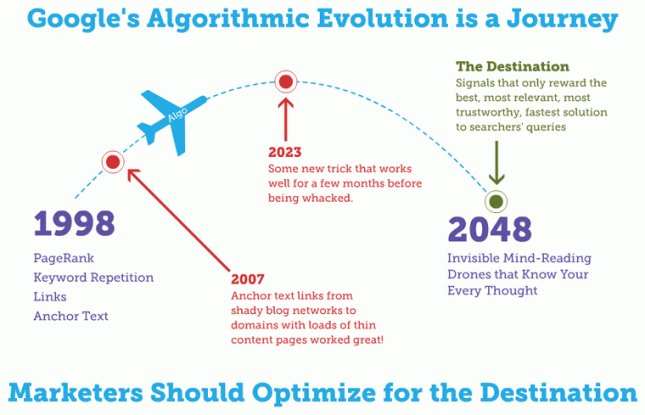As thinkers, leaders and crafters, marketers are always trying to stay on top of the trends that pertain to their target audiences. With the lines between B2B and B2C marketing rapidly dissolving, it’s apparent that regardless of industry — marketers are shifting towards a more humanistic approach to tone. It’s this factor that makes content the leading foot in any marketing initiative.
Nevertheless — with more and more marketers jumping on this way of connecting with their audiences, the playing field is becoming tougher to break through. Over the past few years, ad blocking has been a strong tool in consumers’ back pockets used in order to bypass unwanted content.
There are tons of stats and reports that support the creation of content, but ironically enough — it can be difficult to sort through when there’s a plethora of information all vying for your attention. You’ve been provided time and time again with the what of content marketing, but in this post we distill and provide you with why content can help you become a more effective marketer.
Content gains trust
Everyday, 27 million pieces of content are shared. Some of it is great, others not so great. Content can serve many purposes, but the foundation should be to build off of something that creates value. This can be value that extends towards your brand, thought leadership, relevant analysts, or consumers.
About 74% of customers prefer to get to know a brand through articles than through ads. Sure, you can create brand awareness and be promote your latest eBook, but if you aren’t creating supporting content to continue the conversation with your audience, you are doing more harm than good by cutting the journey short.
Content is SEO friendly

SEO used to be confined to being more technical as it hinged on URLs, tags, sitemaps, etc. At a time when shallow content made it easy for Google’s crawlers to make a mark for websites, the weak content hauling in the search traffic wouldn’t be able to keep readers once the content was discovered. Now SEO has opened up and allowed content to support its goals by giving the user the power and voice to speak up for content that resonates.
SEO and content compliment one another very well in that content directly satisfies the needs that SEO creates. Marketers who aren’t creating compelling content are having a difficult time with SEO. According to a July 2015 report from Acsend2, 33% of marketers said that a lack of quality content has been a significant challenge to SEO success. This shortcoming stems from the need of original, high-quality content. The more valuable a piece of content is, the more likely it is that readers will spend more time on the page and share across their social networks.
Content helps convert

In addition to building your brand and empowering your audiences, content helps with pushing your prospects and leads down the funnel. Leads who are nurtured with targeted content produce a 20% increase in sales opportunities. This starts with the first interaction with your site. Website conversion rate is almost 6 times higher for content marketing adopters versus non-adopters.
Even if you have a list of return clients, equipping them with awesome content that helps them do their job better or makes their day-to-day a bit less stressful not only keeps them happy, but makes them strong evangelists for your brand. Creating content that is readily shareable makes it that much easier for them to spread the word.
Content speaks better than advertising
Creating more content isn’t the answer, however. This past year alone, US ad blocking grew by 48% to reach 45 million active users. The rise in ad blocking is pushing publishers, advertisers, consumer groups, and tech vendors to think of new ways of bypassing these speed bumps. More often than not, consumers feel bombarded by content that is neither useful nor entertaining. The high use of ad blocking shows just how important it is for consumers to take back their virtual experience.

Supporting this growth in ad blocking is Apple’s recent iOS update that broadens the tool’s reach by supporting apps that filter out ads and other noisy content on the mobile front. Youtube is also joining the ad-free experience by launching YoutubeRed. This move towards buying-in to opt-out of ads gives consumers a louder voice as they stand their ground against unwanted content.
In this same light, of those not currently using ad blocking, 41% say they would consider using the tool if the quantity of ads increased from what they typically see — 57% for those aged 18-34. This raises the question of whether consumers would be less likely to use ad blocking if the content that interrupts their experience were more relevant and personalized? This is a huge turning point for marketers given the spike in native ads, sponsored posts, and other paid content. We all consume content, and as marketers, we should be hyperaware of the content we create for our audiences.
We’re human after all
Just because it’s predicted that customers will manage 85% of their relationships without talking to a human by 2020, it does not mean that customers expect to interact with a robot. Whether your goal as a marketing team is to raise awareness, drive engagement, or build your client list, your content marketing will be successful if you make sure your content goals are tied to your company’s major business objectives.
How content will support your bottom line can take many different shapes. Keep your content short, visual, and packed with tidbits that will empower your audience.
If you’re thinking about how you’ll apply these findings to your 2016 marketing plan, download our latest eBook, The Visual Content Playbook for Social Media Marketing, to see how you can get a head start on one of the fastest growing marketing channels.
The post The Case for Content Marketing appeared first on Visually Blog.
from Visually Blog
http://blog.visual.ly/case-content-marketing/

No comments:
Post a Comment